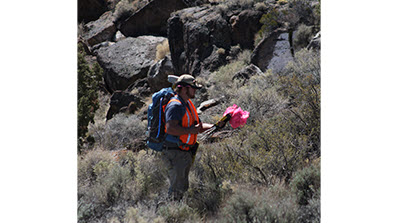The U.S. Department of Energy Environmental Management EM Nevada Program recently completed a unique survey involving electrical energy from a controlled source and audio frequency signals to explore the geology that controls groundwater flow patterns.
Explorations such as this—at the fourth of four groundwater characterization areas of a portion of the Pahute Mesa—are crucial to the program’s mission to continually monitor ground water on and around the Nevada National Security Site (NNSS).
The innovative, collaborative process will inform key EM decisions necessary to achieve regulatory closure at the Pahute Mesa groundwater area, ultimately promoting the protection of human health and the environment.
Previous wells drilled in and around the Pahute Mesa groundwater area have been deep wells, with depths greater than 5,000 feet below ground surface. Drilling to these depths is costly, so gathering as much data as possible is key to cost efficiency.
The Controlled-source Audio-frequency Magnetotellurics (CSAMT) survey can map to depths of around 3,000 feet. After reviewing the results of the survey along with existing sampling data and observations from other proximal wells, the program will be better positioned to determine whether and where to drill additional monitoring wells, which will be valuable long term in making informed decisions for a path forward for corrective actions in the Pahute Mesa groundwater area.

The CSAMT geophysics method uses electrical energy from a controlled source, varying the frequency signals into the ground from one location and measuring the received electric and magnetic fields in the area being studied. A transmitter is placed at a distance from the receiver, which can cover large areas. The CSAMT scan can be likened to an electrical version of a sonogram, which uses high-frequency sound waves.
This technology has been in use since 1978 and has been employed on the NNSS in the past. For the latest application at Pahute Mesa, crew members collected data every 100 meters along three receiver lines a certain distance from two fixed transmitter locations. From data collected, the team measured the electronic current’s resistance, and in turn, provided a snapshot of the geology below the ground’s surface.
Pahute Mesa is the third of four groundwater corrective action areas on the NNSS to go through the regulatory closure process. By the end of 2028, EM anticipates a safe, secure and successful transition of the Pahute Mesa groundwater corrective action area into long-term monitoring. This action will complete EM Nevada’s groundwater mission at the NNSS. It is anticipated that long-term stewardship responsibilities for closed groundwater corrective action areas will thereafter be transferred to the National Nuclear Security Administration, which manages the NNSS.
To learn more about EM Nevada’s environmental cleanup work at the NNSS, please visit: https://www.energy.gov/em/nevada-national-security-site-nnss.

